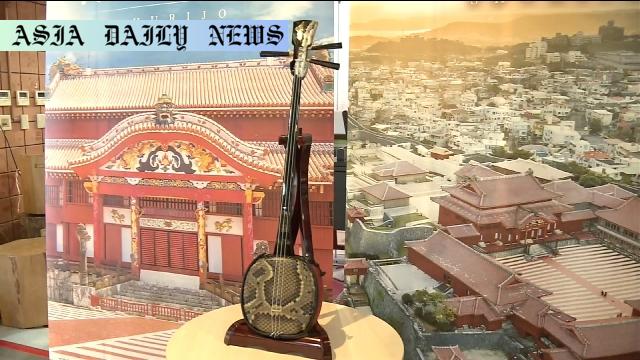Sanshin: Special instrument symbolizes reconstruction & hope.

A Collaborative Effort Fuelled by Hope
The sanshin, a traditional Japanese three-stringed instrument, has emerged as a beacon of hope and a powerful symbol of resilience, bringing together the communities of Okinawa and Ishikawa Prefectures. This captivating creation, unveiled in Okinawa’s Naha City, serves as a testament to the enduring spirit and artistry of the regions, celebrating both tradition and collaboration. The instrument was specifically designed to play a role in supporting reconstruction efforts after devastating events impacted the two areas.
Okinawa’s iconic Shuri Castle, a cultural landmark, suffered extensive damage due to a destructive fire in 2019. Meanwhile, Ishikawa Prefecture’s scenic Noto Peninsula faced consecutive natural disasters, including a major earthquake and severe flooding in 2024. Amidst these challenges, artisans and communities from both regions came together to create a unique sanshin, integrating traditional techniques and aesthetic elements from Okinawa and Ishikawa. This inspiring initiative aims not only to support rebuilding but also to remind people of the power of unity and shared effort during times of adversity.
The Beauty of Craftsmanship and Cultural Significance
Work on this special sanshin commenced in December and drew upon the skilled craftsmanship of artisans from both regions. The instrument’s body incorporates timber sourced from the rebuilding of Shuri Castle’s main hall, symbolizing resilience and regeneration. Its decorative textiles combine traditional fabrics woven in Okinawa and Ishikawa, representing a harmonious blend of two distinct cultural heritages.
Further enhancing its aesthetic appeal, Okinawa-based lacquer artisan Nakamine Miki applied a layer of lacquer, while Ishikawa’s craftsman masterfully used a metal powder-sprinkling technique to depict the picturesque mountain ranges, ocean views, and snowflakes characterizing the geography of the Noto Peninsula. This dual craftsmanship is not only a nod to the respective traditions but also a message of unity and coexistence, as different communities joined forces to produce a single piece of art that resonates deeply within their shared recovery journey.
An Instrument of Celebration and Inspiration
During the unveiling ceremony, the sanshin was used to perform a traditional Okinawan celebratory tune, captivating attendees with its rich, resonant tones. Nakamine Miki expressed his joy in seeing the collaboration come to life, stating that the sanshin represents the seamless integration of Okinawan and Ishikawan craftsmanship. He expressed his hopes that its sounds will inspire many individuals, reflecting themes of hope, tradition, and the promise of new beginnings.
Similarly, Akio Sakaguchi, head of a group of Wajima-nuri lacquerware craftsmen in Ishikawa, articulated his gratitude and pride over the project. He acknowledged the overwhelming support among artisans from both regions and emphasized the importance of art and craftsmanship in healing and solidarity. This sentiment reverberated throughout the event, transforming the unveiling into a poetic display of cultural preservation and human connection.
Looking Ahead: The Role of Art in Reconstruction
The creation of this unique sanshin exemplifies the broader role art and culture can play in facilitating social recovery after crises. The instrument not only stands as a physical embodiment of resilience but also doubles as a platform to foster dialogue and cultural exchange between affected communities. It serves as a lighthouse guiding people through challenging times, reminding them that hope and creativity can emerge even amidst devastation.
With its powerful blend of symbolism and unique craftsmanship, the sanshin is far more than just a musical instrument. It’s a message to the world — that art knows no boundaries and has the power to unite, heal, and inspire. For those affected by the challenges of recent history in Okinawa and Ishikawa, it lights the way toward collective empowerment and renewal. The harmonious integration of regional techniques and artistry speaks volumes about how humans can transcend obstacles when they come together with a shared vision.
Commentary
Reflecting on the Unity Behind the Sanshin
The story of the special sanshin crafted from the ashes of Shuri Castle’s tragedy and Ishikawa’s natural disaster recovery is deeply moving. Its creation not only underscores the resilience of these communities but also rekindles hope, encapsulated in the delicate designs and collaborative efforts of artisans across regional lines. This unveiling is a poignant reminder that beyond the tangible reconstruction of buildings and landscapes, there lies an equally important dimension: the healing of cultural identities and human connections.
A Testament to Human Connection
What captures attention most vividly about this sanshin is the intricate collaboration between overwhelmingly different cultural and artistic expressions: Ishikawa’s Wajima-nuri lacquer techniques and Okinawa’s cherished sanshin craftsmanship. By weaving these traditions into one instrument, communities bridge gaps not otherwise easily crossed. It is a creative endeavor symbolizing interconnectedness and shared humanity. Amid dark times, initiatives like this remind us that beauty and compassion can arise even from the most challenging circumstances.
The Role of Art in Times of Crisis
For me, this project is a great example of how art plays a powerful role in helping societies rebuild after disaster. Cultural restoration projects such as these give people the strength to look forward while safeguarding traditions. The sanshin’s story is an invitation for global audiences to realize the potential of mutual aid, creative expression, and shared purpose.


